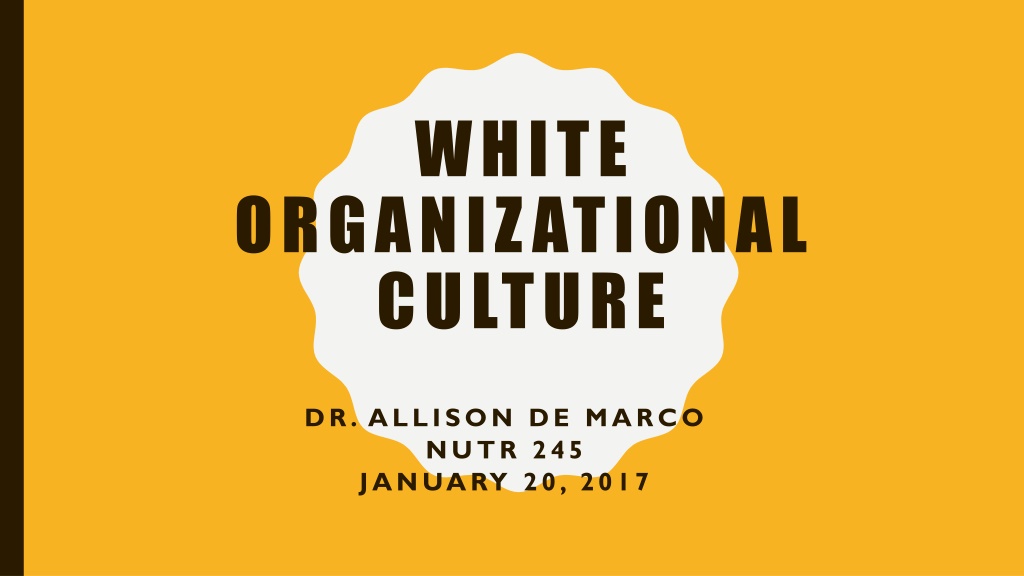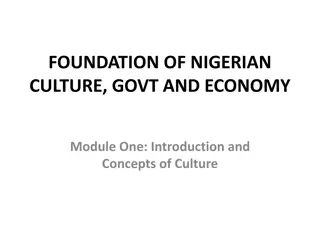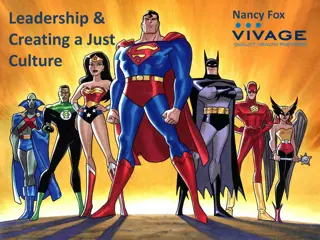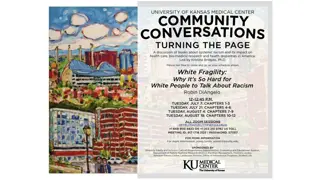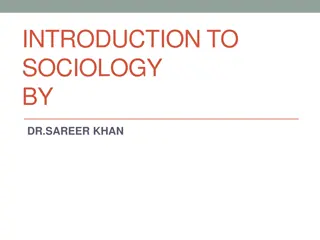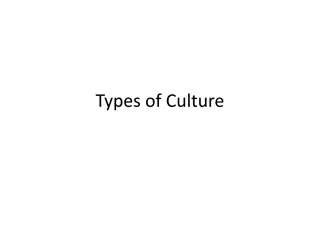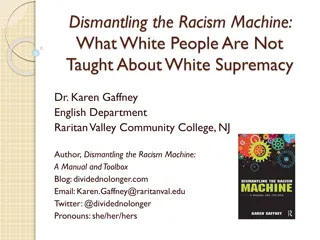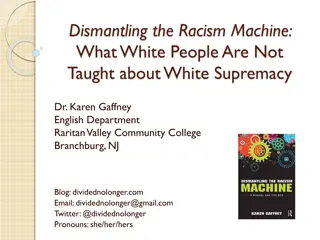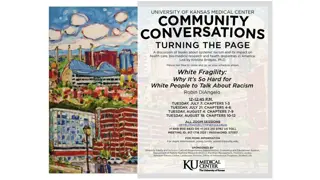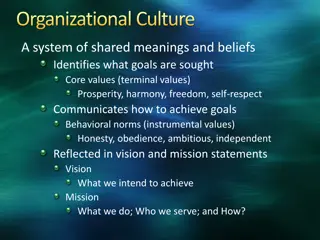Understanding White Supremacy Culture in Organizations
Explore the manifestations of white supremacy culture in organizations, including perfectionism, sense of urgency, defensiveness, and quantity over quality. Learn about antidotes to combat oppressive behaviors and foster inclusivity and diversity. Gain insights from case studies and discussions on organizational anti-racism efforts.
Download Presentation

Please find below an Image/Link to download the presentation.
The content on the website is provided AS IS for your information and personal use only. It may not be sold, licensed, or shared on other websites without obtaining consent from the author. Download presentation by click this link. If you encounter any issues during the download, it is possible that the publisher has removed the file from their server.
E N D
Presentation Transcript
WHITE ORGANIZATIONAL CULTURE DR. ALLISON DE MARCO NUTR 245 JANUARY 20, 2017
OVERVIEW Organizational Culture Manifestations How these are oppressive Antidotes Case Study: CEF progress towards becoming an anti-racist organization Activity: Organizational Anti-Racism Assessment Discussion questions What is your organization doing well? Where does your organization need work?
White Supremacy Culture Culture = Shared patterns of behaviors and interactions, cognitive constructs, and affective understanding that are learned through a process of socialization (Center for Advanced Research on Language Acquisition). White supremacy = A system that maintains legal, political, and economic privilege for whites (PBS Learning Media)
Manifestations of White Supremacy Culture [Source: Tema Okun, dRworks]
PERFECTIONISM Little appreciation expressed for the work that others are doing, appreciation goes mostly to those who already get most credit Antidotes Develop a culture of appreciation Learn from mistakes
SENSE OF URGENCY Makes it difficult to take the time to be inclusive Discourages democratic and/or thoughtful decision-making Antidotes Realistic work plans Increased discussion/planning time Set goals for inclusivity and diversity
DEFENSIVENESS Org structure set up and energy used to prevent abuse and protect power Criticism of those in power viewed as threatening and inappropriate Energy spent to make sure feelings aren t hurt Antidotes Understand that structure can t facilitate/prevent abuse Understand link between defensiveness and fear Work on own defensiveness
QUANTITY OVER QUALITY All resources directed toward producing measure goals Measurable things are more valued Little or no value attached to process Antidotes Include process/quality goals in planning Look for ways to include process goals
WORSHIP OF THE WRITTEN WORD The Organization doesn t take into account/value other ways that information is shared Those with strong documentation and writing skills are more highly valued Antidotes Determine what needs to be documented Come up with alternative ways to document what is happening Recognize contributions/skills that everyone brings Make sure anything written is understandable
ONE RIGHT WAY Once people are introduced to the right way they will adopt it If they do not adapt/change, then something is wrong with them Antidotes Accept that there are many ways to the same goal Never assume your org knows what s best for a community
PATERNALISM Decision-making is clear to those in power and unclear to those without it Those in power think they are capable of making all the decisions Those without power understand they don t have it and who does Antidotes Make sure everyone know who makes decisions Include those affected by decisions in decision-making
EITHER/OR THINKING Things are either/or, good/bad, right/wrong, with us/against us No sense that things can be either/or Leads to trying to simplify complex things Creates conflict and increases sense of urgency Antidotes Notice when people use either/or language Notice when people are simplifying complex issues Slow down and encourage a deeper analysis
POWER HOARDING Little, if any, value around sharing power Power seen as limited Those with power feel threatened when change is suggested Those in power assume they have the best interests of the org at heart Antidotes Develop power sharing and include in value s statement Discuss what good leadership looks like Understand that change is inevitable
FEAR OF OPEN CONFLICT Those in power fear expressed conflict and avoid it When someone raises an issue that causes discomfort, response it to blame the person for raising the issue Emphasis on being polite Antidotes Role play ways to handle conflict Don t require those who raise hard issues to raise them in acceptable ways
INDIVIDUALISM Little experience/comfort with working in team Believe responsible for handling problems alone Accountability goes up and down Desire for recognition and credit Competiton more highly valued than cooperation Antidotes Include teamwork as important org value Make sure org working toward shared goals Create culture where problems are brought to the group
IM THE ONLY ONE Connected to individualism Little or no ability to delegate work to others Antidotes Evaluate based on ability to delegate Evaluate based on ability to work as part of a team
PROGRESS IS BIGGER, MORE PROGRESS IS BIGGER, MORE Seen in how we define success Progress = org which expands or serves more people Gives no value to the cost Antidotes Ask how the actions of the group now will affect the future Make sure cost/benefit analysis includes all costs Include process goals in planning Outside evaluation
OBJECTIVITY OBJECTIVITY Belief that there is such thing as being neutral Belief that emotions are inherently destructive, irrational, and shouldn t play a role in decision-making Requiring people to think in linear (logical) fashion Antidotes Recognize there are different world views that impact how people understand things Sit with discomfort Assume all have valid points
RIGHT TO COMFORT RIGHT TO COMFORT Belief that those in power have right to emotional/psychological comfort Scapegoating those who cause discomfort Equating individual acts of unfairness against white people with systemic racism that daily impacts people of color Antidotes Understand discomfort is at root of all growth/learning Welcome discomfort Deepen analysis of racism and oppression
Perfectionism Sense of Urgency Defensiveness Quantity over Quality Worship of the Written Word Only One Right Way Paternalism Either/Or Thinking Power Hoarding Fear of Open Conflict Individualism I m the Only One Progress is Bigger, More Objectivity Right to Comfort
CASE STUDY: COMMUNITY CASE STUDY: COMMUNITY EMPOWERMENT FUND EMPOWERMENT FUND Founding to 2014 Institutional racism not in vocabulary Talk about prejudice and privilege Member base disproportionately Black Advocates disproportionately White and non-Black POC Spring 2014 4 staff to REI Created a WIPPO (Workshop on Institutional Power, Privilege and Oppression) Much discussion
CEFS WORK TOWARD BECOMING CEF S WORK TOWARD BECOMING AND ANTI AND ANTI- -RACIST ORGANIZATION RACIST ORGANIZATION Strategic Planning 2015 Intentional planning with commitment to anti-oppression Training staff Determine how best to engage members Current Status REI training for all staff and board Integrated WIPPO into advocate training Anti-racism advocacy
CEFS WORK TOWARD BECOMING CEF S WORK TOWARD BECOMING AND ANTI AND ANTI- -RACIST ORGANIZATION RACIST ORGANIZATION Plan Going Forward Training/Education Read/Reflect/Discuss Organizational practices Do no harm
ORGANIZATIONAL ORGANIZATIONAL ANTI ANTI- -RACISM RACISM ASSESSMENT ASSESSMENT
Group Discussion: - What is your organization doing well? - Where does your organization need work?
